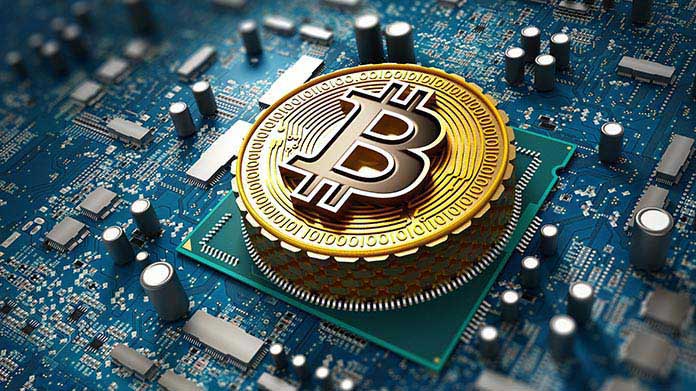Bitcoin mining is performed by high-powered computers that solve complex computational math problems; these problems are so complex that they cannot be solved by hand and are complicated enough to tax even incredibly powerful computers.

The process of discovering new Bitcoin is described as mining because it resembles the process of mining for any other resource. With gold mining, miners search and dig through the earth in hopes of striking gold.
With Bitcoin, miners attempt to find Bitcoin through solving complex mathematical problems. Blockchain is the technology that the cryptocurrency is built on. It is a ledger that is publicly distributed and records every Bitcoin transaction.
It is literally a digital chain of blocks. Each block contains a group of Bitcoin transaction information. Miners add to the blockchain by using computer processing power to solve complex mathematical problems. Solving the problems will result in the block being successfully added to the chain. The miner who correctly solves the problem is awarded Bitcoin.
The above forms the basis of the complex process of Bitcoin mining. It helps keep the payment network secure and trustworthy. The network is built on a peer-to-peer network, meaning that every single miner across the globe is contributing their computing power to maintain the network, confirm its transactions, and keep them secure.
Bitcoin mining is the process by which new transactions are added to the blockchain and new Bitcoin are created. Miners use specialized computers to solve complex mathematical problems and are rewarded with a certain number of Bitcoin for each block of transactions they add to the blockchain.
Here are the steps to start mining Bitcoin:
- Choose a mining hardware: In order to start mining Bitcoin, you will need to invest in specialized mining hardware. There are several types of mining hardware available, each with different performance levels and price points. It is important to research and compare different options to find the hardware that is best suited to your needs and budget.
- Set up a Bitcoin wallet: Before you can start mining, you will need to set up a Bitcoin wallet to store your earnings. There are several types of wallets available, including software, mobile, and hardware wallets. It is important to choose a wallet that is secure and supports the type of mining hardware you are using.
- Join a mining pool: Many miners join a mining pool, which is a group of miners who combine their computing power to increase their chances of finding a block and earning Bitcoin. By joining a mining pool, you can earn a share of the Bitcoin produced by the pool, based on your contribution to the pool’s computing power.
- Download and install mining software: Once you have your hardware and wallet set up, you will need to download and install mining software. This software is used to connect your mining hardware to the mining pool and the Bitcoin network.
- Start mining: After you have set up your hardware, wallet, and mining software, you can start mining Bitcoin. The mining software will use your hardware to solve mathematical problems and, if successful, you will earn a share of the Bitcoin produced by the pool.
It is important to note that Bitcoin mining requires a lot of electricity and can be expensive. Additionally, the difficulty of mining Bitcoin increases over time, which means that it may not be profitable to mine Bitcoin in the long term. It is important to carefully consider the costs and potential rewards before starting to mine Bitcoin.
Jump to Sections
10 Minutes per Block
Satoshi Nakamoto, the creator of Bitcoin, designed the Bitcoin network to allow for a block to be mined every 10 minutes. To maintain this 10-minute pace, the difficulty of the mathematical problems adjust automatically.
When there are more miners and more computing power attempting to mine, the level of difficulty will increase. When there are fewer miners and less computing power, the level of difficulty will decrease.
Evolution of Mining
At the beginning stages of Bitcoin in the early 2000s, individuals interested in Bitcoin mining were able to do so using their personal computers. As its popularity increased, so did the difficulty of mining.
To accommodate the growing level of difficulty, more computer processing power was required. Soon, miners used gaming computers to attempt to mine Bitcoin. The process repeated, and the mining difficulty and amount of computing power required increased.
Eventually, computers and chips were created for the sole purpose of mining Bitcoin. Today, it requires efficient hardware – those with strong computing abilities and energy efficiency.
Solving the Bitcoin algorithm to add to the blockchain and receiving Bitcoin requires an immense amount of electricity. Keeping electricity costs low is key to making Bitcoin mining profitable and sustainable.
Mining Is Used to Issue new Bitcoins
Traditional currencies–like the dollar or euro–are issued by central banks. The central bank can issue new units of money ay anytime based on what they think will improve the economy.
Bitcoin is different.
With Bitcoin, miners are rewarded new bitcoins every 10 minutes.
The issuance rate is set in the code, so miners cannot cheat the system or create bitcoins out of thin air. They have to use their computing power to generate the new bitcoins.
Miners Confirm Transactions
Miners include transactions sent on the Bitcoin network in their blocks.
A transaction can only be considered secure and complete once it is included in a block.
Why?
Because only a when a transaction has been included in a block is it officially embedded into Bitcoin’s blockchain.